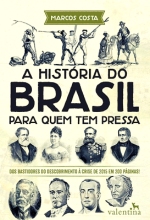Ultra-fast learning – José Ítalo dos Santos Nascimento’s (URCA) review of the book “História do Brasil para quem tem pressa”, by Marcos Costa

Abstract: This work offers a concise overview of Brazilian history, though it is criticized for its lack of depth and detail, particularly in regard to subaltern perspectives. While the work is appealing to casual readers, it does not meet the academic standards for detailed studies.
Keywords: History of Brazil, historical synthesis, and brazilian historiography.
The objective of the book is to provide a concise overview of Brazilian history in order to address questions that require historical knowledge. It is part of the collection “História para quem tem pressa” (History for those in a hurry), a publication that has gained significant attention due to its accessibility and brevity. However, it is not considered a suitable choice for those seeking a more detailed and academic analysis of national history.
 Marcos Costa holds a Bachelor’s, Master’s, and Doctorate from the Universidade Estadual Paulista Júlio de Mesquita Filho (Unesp). In 2007, he completed his dissertation, entitled Biografia Histórica: a trajectória intelectual de Sérgio Buarque de Holanda entre os anos de 1930 e 1982, under the guidance of Carlos Eduardo Jordão Machado. The author has experience in the areas of Brazilian history, Brazilian historiography, and history theory.
Marcos Costa holds a Bachelor’s, Master’s, and Doctorate from the Universidade Estadual Paulista Júlio de Mesquita Filho (Unesp). In 2007, he completed his dissertation, entitled Biografia Histórica: a trajectória intelectual de Sérgio Buarque de Holanda entre os anos de 1930 e 1982, under the guidance of Carlos Eduardo Jordão Machado. The author has experience in the areas of Brazilian history, Brazilian historiography, and history theory.
In the introduction to História do Brasil para quem tem pressa, the author poses several questions: Why, from a political point of view, is Brazil still a very fragile country? Why isn’t our immense natural wealth translated into a universal welfare state? What was behind the voyage that brought Cabral to Brazil? Why was the territory divided into Hereditary Captaincies? The book poses these questions in order to describe six centuries of history in less than 200 pages. It attempts to answer why we were the last Western nation to officially abolish slave labor.
The first chapter of the book talks about mercantilism and Portugal’s role in the great navigations. It also highlights some of the situations that contributed to the arrival of the Portuguese in the territory that is now called Brazil. The work’s formatting begins with a discussion in a few paragraphs and then presents a paragraph in capital letters, akin to a kind of binder, thus tracing a route between trade, its expansion, the taking of Ceuta, the taking of Constantinople, the trajectory of Dom João II, Cabral’s voyage, descriptions by Américo Vespúcio, and the hereditary captaincies. The author’s argument is presented in the first chapter, which lasts less than 15 pages. It can be argued that the author could have better exemplified the issues of the hereditary captaincies, including the names of the individuals and the reasons why they did not succeed. The author even attempts to do this by exposing a cartographic source without transcribing it, which may divert the reader’s attention and make reading less fluid.
In the second chapter, the author recounts experiences from 1534 to 1822, which marks the period of Brazilian Independence. The structure of the text follows the same format as the first chapter, commencing with an overview of Portugal’s exploration interests in Brazil and subsequently progressing to the mines of Potosí, the General Government, economic relations based on sugar, and the scarcity of precious metals (gold). The encounter and otherness, African slavery, Felipe II in Spain and the Iberian question, the Reformation and Counter-Reformation, the Dutch invasion, gold in the 17th century and the Inconfidência mineira, the arrival of the royal family, English interests and the Pernambuco Revolution. These themes are discussed in 23 pages. In this context, it is worth noting that the exploration of indigenous and African themes is insufficient to avoid romanticizing relations between enslaved people and their masters. This is surprising given the availability of accessible sources, such as texts by John Manuel Monteiro, Eduardo Viveiros de Castro, as well as indigenous authors who are rewriting their history, such as Ailton Krenak and Davi Kopenawa.
The third chapter offers commentary on the monarchical period, with a particular focus on the first and second reigns of Dom Pedro I and Dom Pedro II. The author provides insights into the Confederation of Ecuador, the rise of the coffee oligarchy, the Eusébio de Queiróz Law, the Golden Law, and the coup that led to the establishment of the Republic. This chapter represents a significant contribution to the historiographical debate, engaging with historical sources in a constructive manner.
In the fourth chapter, the book provides a concise overview of the republican period (1889-2015), summarizing the presidencies of each leader and accompanied by black and white photographic reproductions. The text also contextualizes the provisional government, providing an account of the political and military achievements of Deodoro da Fonseca and Floriano Peixoto. The narrative then proceeds to describe the Republic of Coffee with Milk, a period during which the oligarchies of Minas Gerais and São Paulo were dominant. The text then discusses the decline of this system, before moving on to the governments of Getúlio Vargas. Given that the text is written by a historian, it is evident that the author is familiar with the principles of the historical method and the general tenets of the historian’s craft. This includes the necessity to provide a platform for contradictory perspectives, to disseminate information about the existence of multiple versions, and to include footnotes that acknowledge the existence of ambiguities and other interpretations. It is clear that historians are not in a hurry to reach a conclusion.
Conversely, it is important to acknowledge that the majority of readers of history, including this book, tend to be biased and prefer a concise history that is straightforward in its interpretation. The text could, for instance, address the role of subalternized peoples within these historical dynamics, emphasizing their objectives and interests, such as those of indigenous, black, and quilombola populations.
The policy of burning coffee in the port of Santos (Photo: “Gosto Amargo”, 1930/(Costa, 2016)
Overall, the book has its merits, as evidenced by the praise it has received through comments made on social networks, such as Skoob, which has become a meeting point for readers. Despite its lack of detail and theoretical basis, the book draws attention and manages to satisfy consumers’ curiosity about Brazilian history. The book fulfills its objective of taking a journey through the history of Brazil, despite the fact that its content does not occupy a significant place within the academic community as a reference for inspiring studies.
Summary of História do Brasil para quem tem pressa
- Prefácio
- Introdução
- 1. Os Antecedentes 1453–1534
- 2. Período Colonial 1534–1822
- 3. Período Monárquico 1822–1889
- 4. Período Republicano 1889–2015
- Índice onomástico
- Sobre o autor
- Notas
Reviewer
 José Ítalo dos Santos Nascimento is pursuing a master’s degree in History at the Universidade Federal Rural de Pernambuco (UFRPE) and holds a degree in History from the Universidade Regional do Cariri (URCA). He has published several works, including: The following works are worthy of mention: “Pega dente de cachorro“: mulheres indígenas no Ceará colonial, início do século XVIII e O efeito além dos palcos: reflexões sobre o espetáculo Prefiro rosa e não azul (2016), da Companhia de Teatro e Dança Traquejo, na cidade de Exu-PE. ID LATTES: http://lattes.cnpq.br/8823269543249881; ID ORCID: https://orcid.org/0000-0002-9455-2476; Redes sociais, Instagram: @italo_nascimentu; E-mail: santos.italo@urca.br.
José Ítalo dos Santos Nascimento is pursuing a master’s degree in History at the Universidade Federal Rural de Pernambuco (UFRPE) and holds a degree in History from the Universidade Regional do Cariri (URCA). He has published several works, including: The following works are worthy of mention: “Pega dente de cachorro“: mulheres indígenas no Ceará colonial, início do século XVIII e O efeito além dos palcos: reflexões sobre o espetáculo Prefiro rosa e não azul (2016), da Companhia de Teatro e Dança Traquejo, na cidade de Exu-PE. ID LATTES: http://lattes.cnpq.br/8823269543249881; ID ORCID: https://orcid.org/0000-0002-9455-2476; Redes sociais, Instagram: @italo_nascimentu; E-mail: santos.italo@urca.br.
To cite this review
COSTA, Marcos. História do Brasil para quem tem pressa. Rio de Janeiro: Valenina, 2016. 200p. Review by: NASCIMENTO, José Ítalo dos Santos. Ultra-fast learning. Crítica Historiográfica. Natal, v.4, n.16, Mar/Apr, 2024. Available at <Ultra-fast learning – José Ítalo dos Santos Nascimento’s (URCA) review of the book “História do Brasil para quem tem pressa”, by Marcos Costa – Crítica Historiografica (criticahistoriografica.com.br)>.
© – Authors who publish in Crítica Historiográfica agree to the distribution, remixing, adaptation and creation of their texts, even for commercial purposes, provided that they are given due credit for the original creations. (CC BY-SA).









